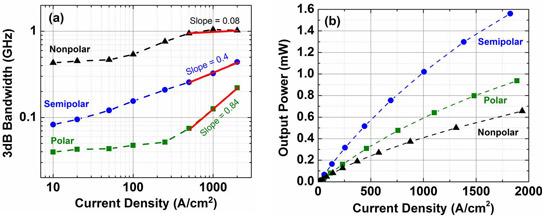- News
9 February 2018
Opening up bandwidth for visible light communication technology
University of New Mexico and University of California Santa Barbara in the USA have been studying the effect of crystal orientation (Figure 1) on the modulation bandwidth of indium gallium nitride (InGaN) light-emitting diodes (LEDs) [M. Monavarian et al, Appl. Phys. Lett., vol112, p041104, 2018].

Figure 1: (a) Crystallographic planes studied and (b) normalized s-parameter (S21) response of LEDs with polar (green squares), semi-polar (blue circles), and non-polar (black triangles) orientations with same device geometry operating at 1kA/cm2. Inset: operating device probed using GSG RF electrode.
In particular, the researchers sought high bandwidth at lower current injection where the efficiency of InGaN LEDs is higher, reducing ‘droop’ effects. The non-polar m-plane (10-10) orientation was found to have the largest 3dB (half-power) bandwidth, with a value of more than 1GHz down to 500A/cm2 injection.
The team suggests future uses of such devices as “visible-light communication (VLC), plastic optical fiber (POF) communication, and underwater optical communication (UWOC),” explaining: “For communication applications, advantages of LEDs compared to diode lasers include their lower cost, longer operating lifetime, lower temperature dependence, compatibility with existing lighting systems, and lower emission directionality.”
The LEDs studied contained three InGaN quantum wells. The well thicknesses were chosen to maximize optical output power: 4nm for the polar c-plane (0001) and semi-polar (20-2-1) orientations, and 6nm for the non-polar sample. Freestanding semi-polar and non-polar GaN substrates were supplied by Mitsubishi Chemical. The polar sample was grown on c-plane sapphire.
The materials were fabricated into 60μm-diameter circular mesa LEDs with indium tin oxide (ITO) transparent conductor on the p-contact layer, titanium/aluminium/nickel/gold n-contact, chromium/gold contact pads, and ground-signal-ground radio frequency (GSG RF) electrodes. The micro-LED structures were designed to reduce the impact of parasitic resistance-capacitance time constant effects on modulation bandwidth.
The 3dB (half-power) bandwidths at 1kA/cm2 current density injection were 1050MHz, 325MHz and 125MHz for the non-polar, semi-polar and polar LEDs, respectively, correcting for the frequency responses of the RF cables, bias tee, and low-noise amplifier. The non-polar LED maintained its ~1GHz bandwidth down to 500A/cm2 (Figure 2).

Figure 2: (a) Bandwidth and (b) optical output power versus current density for devices with polar (green squares), semi-polar (blue circles), and non-polar (black triangles) orientations.
The researchers explain the larger bandwidth for the non-polar LED as being due to better wavefunction overlap between the electrons and holes that are desired to recombine into photons, compared with the semi-polar and completely polar orientations.
At higher current, the polar LEDs begin to benefit from coulomb screening of the charge polarization electric fields that impair performance. Hence, the bandwidth increases more rapidly above 500A/cm2, compared with the semi-polar and non-polar orientations.
In terms of raw output power, the semi-polar LED gives more than twice the intensity of the non-polar device.
The researchers used their results to assess the carrier life-times of the three devices, finding that the non-polar carriers had shortest life-times, giving faster response to modulation. Unsurprisingly, the semi-polar structure gave a shorter life-time than the fully polar devices.
Short life-times reflect fast recombination, with the upshot of lower carrier density for a given injection current. The team sees the faster recombination of the non-polar orientation as reflecting the more complete overlap of electron and hole wavefunctions.
As the current density increases the polar LED carrier life-time reduces and some c-plane LEDs with bandwidth of the order 1GHz have been reported at 5kA/cm2 injection. However, high current injection means lower efficiency as a result of ‘droop’.
The researchers comment: “LEDs fabricated on non-polar and semi-polar orientations are attractive for achieving higher bandwidths at lower operating currents, which is advantageous for maximizing efficiency, reducing power dissipation, and mitigating issues with thermal management.”
https://doi.org/10.1063/1.5019730
The author Mike Cooke is a freelance technology journalist who has worked in the semiconductor and advanced technology sectors since 1997.


